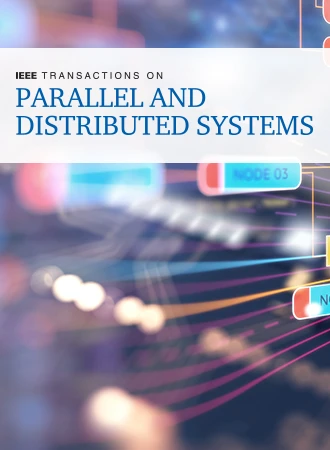A Tail Latency SLO Guaranteed Task Scheduling Scheme for User-Facing Services
IF 5.6
2区 计算机科学
Q1 COMPUTER SCIENCE, THEORY & METHODS
IEEE Transactions on Parallel and Distributed Systems
Pub Date : 2025-02-14
DOI:10.1109/TPDS.2025.3542638
引用次数: 0
Abstract
A primary design objective for user-facing services for cloud and edge computing is to maximize query throughput, while meeting query tail latency Service Level Objectives (SLOs) for individual queries. Unfortunately, the existing solutions fall short of achieving this design objective, which we argue, is largely attributed to the fact that they fail to take the query fanout explicitly into account. In this paper, we propose TailGuard based on a Tail-latency-SLO-and-Fanout-aware Earliest-Deadline-First Queuing policy (TF-EDFQ) for task queuing at individual task servers the query tasks are fanned out to. With the task pre-dequeuing time deadline for each task being derived based on both query tail latency SLO and query fanout, TailGuard takes an important first step towards achieving the design objective. A query admission control scheme is also developed to provide tail latency SLO guarantee in the presence of resource shortages. TailGuard is evaluated against First-In-First-Out (FIFO) task queuing, task PRIority Queuing (PRIQ) and Tail-latency-SLO-aware EDFQ (T-EDFQ) policies by both simulation and testing in the Amazon EC2 cloud. It is driven by three types of applications in the Tailbench benchmark suite, featuring web search, in-memory key-value store, and transactional database applications. The results demonstrate that TailGuard can significantly improve resource utilization (e.g., up to 80% compared to FIFO), while also meeting the targeted tail latency SLOs, as compared with the other three policies. TailGuard is also implemented and tested in a highly heterogeneous Sensing-面向用户业务的尾延迟SLO保证任务调度方案
面向用户的云计算和边缘计算服务的主要设计目标是最大限度地提高查询吞吐量,同时满足单个查询的查询尾部延迟服务水平目标(Service Level Objectives, slo)。不幸的是,现有的解决方案没有达到这个设计目标,我们认为,这在很大程度上是由于它们没有明确地考虑到查询扇出。在本文中,我们提出了基于tail -latency- slow -and- fanout感知的early - deadline - first队列策略(TF-EDFQ)的TailGuard,用于查询任务分散到各个任务服务器上的任务队列。由于每个任务的任务预排队时间截止日期是基于查询尾延迟SLO和查询扇出派生的,因此TailGuard朝着实现设计目标迈出了重要的第一步。为了在资源短缺的情况下提供尾延迟SLO保证,提出了一种查询允许控制方案。在Amazon EC2云中,通过模拟和测试,对先进先出(FIFO)任务队列、任务优先级队列(PRIQ)和尾部延迟-慢速感知EDFQ (T-EDFQ)策略进行了评估。它由Tailbench基准套件中的三种类型的应用程序驱动,具有web搜索、内存中的键值存储和事务性数据库应用程序。结果表明,与其他三种策略相比,TailGuard可以显著提高资源利用率(例如,与FIFO相比,可提高80%),同时还能满足目标尾部延迟slo。此外,TailGuard还在一个高度异构的数据传感服务SaS (Sensing- a- s-a-Service)测试平台上进行了实施和测试,性能提升高达33%。这些结果与模拟结果和Amazon EC2结果一致。
本文章由计算机程序翻译,如有差异,请以英文原文为准。
求助全文
约1分钟内获得全文
求助全文
来源期刊

IEEE Transactions on Parallel and Distributed Systems
工程技术-工程:电子与电气
CiteScore
11.00
自引率
9.40%
发文量
281
审稿时长
5.6 months
期刊介绍:
IEEE Transactions on Parallel and Distributed Systems (TPDS) is published monthly. It publishes a range of papers, comments on previously published papers, and survey articles that deal with the parallel and distributed systems research areas of current importance to our readers. Particular areas of interest include, but are not limited to:
a) Parallel and distributed algorithms, focusing on topics such as: models of computation; numerical, combinatorial, and data-intensive parallel algorithms, scalability of algorithms and data structures for parallel and distributed systems, communication and synchronization protocols, network algorithms, scheduling, and load balancing.
b) Applications of parallel and distributed computing, including computational and data-enabled science and engineering, big data applications, parallel crowd sourcing, large-scale social network analysis, management of big data, cloud and grid computing, scientific and biomedical applications, mobile computing, and cyber-physical systems.
c) Parallel and distributed architectures, including architectures for instruction-level and thread-level parallelism; design, analysis, implementation, fault resilience and performance measurements of multiple-processor systems; multicore processors, heterogeneous many-core systems; petascale and exascale systems designs; novel big data architectures; special purpose architectures, including graphics processors, signal processors, network processors, media accelerators, and other special purpose processors and accelerators; impact of technology on architecture; network and interconnect architectures; parallel I/O and storage systems; architecture of the memory hierarchy; power-efficient and green computing architectures; dependable architectures; and performance modeling and evaluation.
d) Parallel and distributed software, including parallel and multicore programming languages and compilers, runtime systems, operating systems, Internet computing and web services, resource management including green computing, middleware for grids, clouds, and data centers, libraries, performance modeling and evaluation, parallel programming paradigms, and programming environments and tools.
 求助内容:
求助内容: 应助结果提醒方式:
应助结果提醒方式:


